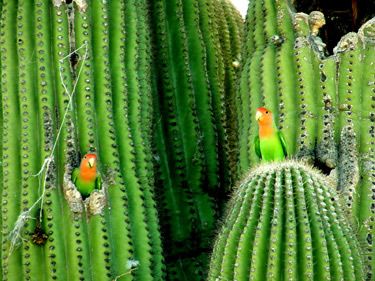14 Fun Facts About Lovebirds
Number one: Lovebirds mate for life
/https://tf-cmsv2-smithsonianmag-media.s3.amazonaws.com/filer/b2/13/b213c952-f57e-4ab2-af08-e4b7e8c3b336/2392033803_ec934ddf87_b.jpg)
It's Valentine's Day. Love is in the air (for some, at least). Humans around the globe will express their love today through chocolate, greeting cards, and a cacophony of stuffed animals.
In the animal kingdom, though, relationships don't often fit with conventional human ideas of love. Female preying mantises feast on their male lovers after sex; red-sided garter snakes mate with multiple partners simultaneously. For most organisms, mating is purely a reproductive strategy to pass on their genetic material to their progeny; in the case of many species, such as voles, even monogamy comes with an evolutionary advantage.
But no animal represents the sentiment of Valentine's Day more than the lovebird. The petite, brightly plumed parrot is a favorite among bird enthusiasts and a popular pet. Lovebirds have inspired scientists and poets alike. Without further ado. here are 14 fun facts about lovebirds.
1. Lovebirds mate for life.
The monogamous birds reach sexual maturity when they're about ten months old. Mating begins with courtship behavior, and can continue throughout their roughly 15-year lifespans. Monogamy is essential to the social stability of flocks and underlies much of their social behavior.
2. Lovebirds pine for each other.
If a mate dies or gets separated from the flock, its companion exhibits erratic behavior that some have likened to depression. Birds kept as pets often don't like being alone and will exhibit similar behavior in captivity.
3. Like overly affectionate couples in restaurants on Valentine’s Day, lovebirds feed each other.
Often after a long separation or stressful period of time, breeding pairs of lovebirds feed each other to re-establish their bond. One bird transfers food to the mouth of its mate, a feeding technique reminiscent of affection in humans—hence the inspiration for the parrots' name.
4. There's more than one species of lovebird.
The nine species classified as lovebirds come all from the genus Agapornis. Most lovebirds have a green body and sport different head feather coloration. Their closest relatives are hanging parrots, found in Asia.
5. Lovebirds are from Africa.
Lovebirds are native to the forests and savannas of Sub-Saharan Africa and Madagascar. Fossils of ancient lovebird species have been unearthed in South Africa, dating to as far back as 1.9 million years ago.
6. But you might see a lovebird at your backyard birdfeeder.
That's if you live in the American southwest, San Francisco or cities in Africa. These areas are home to feral populations, flocks that likely either escaped from an aviary or are the remnants of an abandoned aviary.
7. Lovebirds live in holes.
Lovebirds are cavity dwellers they make their home in holes in trees, rocks or shrubs in the wild. Some species nest in groups, while others pair off to build their nests away from the flock. In urban settings, they might rely on anything from a tree to a crevice in a building. Peach-faced lovebirds in Phoenix, Arizona, often make their homes in cacti.

8. Different lovebird species build their nests in different ways.
Fisher’s lovebirds (Agapornis fischeri) carry single strips of tree bark in their beaks. Peach-faced lovebirds (Agapornis roseicollis), on the other hand, hide bark in their feathers. Scientists believe that the latter's more complex behavior is an ancestral trait, and have used this facet of lovebird nest-building as an example of the intersection of evolved and learned behavior.
9. Some lovebirds are androgynous.
In three species of lovebirds, the males and females have defining characteristics that allow you to tell them apart. For example, among Black-winged lovebirds (Agapornis taranta), males have a crown of red feathers, while females have entirely green plumage. But other species don't have the same degree of sexual dimorphism, making it difficult to determine their sex just from looking at them. In some species, males may be slightly larger than females, but a DNA test is necessary to provide conclusive results.
10. Lovebirds don't eat chocolate.
It might seem like common sense, but save your chocolate and give it to a human. Lovebirds survive on a healthy diet of seeds, berries, fruit, and occassionally insect larva in the wild. In Africa, they're also known as crafty crop pests, as they feast on millet and maize farms.
11. Lovebirds can be mean.
Aggression isn't uncommon in lovebirds. The parrots are territorial, and are known to get along poorly with birds of another species. Within their own kind, lovebirds can also become jealous or hormonal during mating season. In captivity, they've been known to attach both other bird species and other lovebirds, with peach-faced lovebirds the most notorious for aggressive behavior.
12. Lovebirds can carry zoonotic diseases that infect humans.
Some studies suggest that lovebirds can carry yeast bacteria (Cryptococcus neoformans) capable of infecting humans, but they only pick up the bacterial spores if they come into contact with pigeon feces. Other reports find evidence of a parasite called Encephalitozoon hellem in Fishers, peach-faced, and masked lovebirds. The researchers hypothsize that the parasites can spread to humans with compromised immune systems, such as AIDS patients.
13. Some lovebirds might become endangered in the next decade.
The black-cheeked lovebird (Agapornis nigrigenis), native to Zambia and found in parts of Zimbabwe and Botswana, is classified as vulnerable by the IUCN Red Listing of Threatened Species. The biggest problem is drought (possibly driven by long-term climate change), which is drying up regional water sources that flocks rely on. The latest survey puts the black-cheeked lovebird population at around 10,000 birds in total.
14. Lovebirds (sort of) inspired Valentine's Day.
Scholars typically cite a poem by Geoffrey Chaucer as the first evidence of the connection between the religious celebration of Saint Valentine's day and romantic love. The poem, "Parliament of Foules," happens to feature two birds which exhibit all the markings of human love.
/https://tf-cmsv2-smithsonianmag-media.s3.amazonaws.com/accounts/headshot/Screen_Shot_2014-01-27_at_12.05.16_PM.png)


/https://tf-cmsv2-smithsonianmag-media.s3.amazonaws.com/accounts/headshot/Screen_Shot_2014-01-27_at_12.05.16_PM.png)